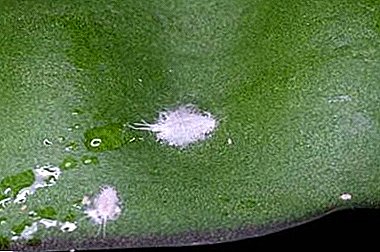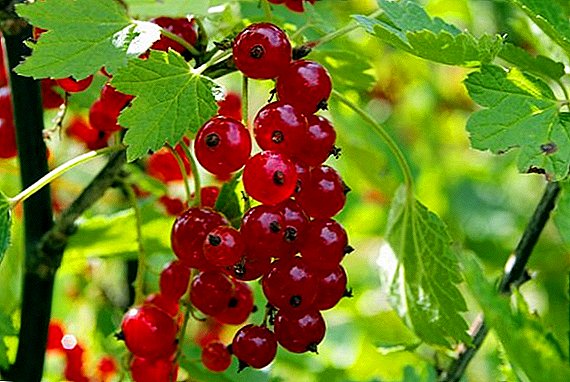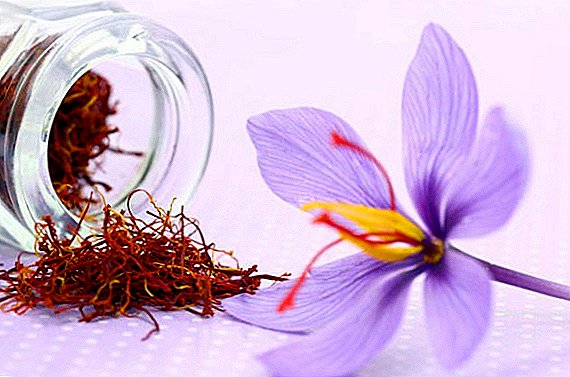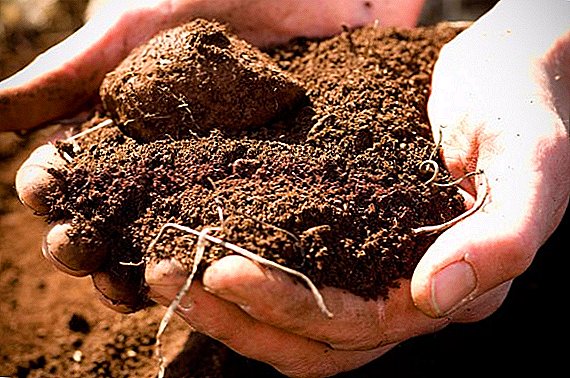
Orchids are capricious house beauties who react painfully to the slightest flaws in conditions of maintenance or care. One of the possible signs of a problem is the bloom on the leaves of a room orchid.
What are the reasons for its appearance? Is there a danger to the plant? How to treat a flower? We understand the causes and consequences together.
What is it and what do the affected parts of the flower look like in the photo?
Depending on the exact factor of the damage, the white patina looks different. In total, there are two common possible causes: a fungal infection (powdery mildew) or an attack of a pest (powdery mealybug).
- For fungal infections, white bloom usually appears on the underside of the leaf. If the deposit is powdered, the texture resembles powder or flour and can be easily removed with a finger - these are symptoms of powdery mildew. With the progression of the disease, the bloom acquires a gray color, extends to the stems and leaves, buds and roots.
- With a parasitic lesion on the leaves appear white flakes. Plaque white, cotton, sticky, sometimes you can also see on the orchid and sticky drops. When attacking a pest, buds and leaves are deformed. If the parasite reaches the root system, the plant begins to slowly die.
Next on the photo you can see how the plants are struck by white bloom.




Why does it appear on the leaves?
White plaque on the leaf plate is most often the result of improper care, which led to a weakening of the immune system of the orchid.
Due to unsuitable conditions of maintenance the metabolism is disturbed, this leads to a change in the composition of the vegetable juice. As a result, the orchid becomes an excellent target for attacks by parasites and the rapid progression of fungal infections. Select the group of main reasons:
- Frequent fertilization with nitrogen fertilizers.
- Dry or excessive humidity in the room.
- Frequent watering - water stagnates in the ground.
- Contaminated soil. The problem arises if the soil for orchids dig in the garden, garden.
- Fallen dead leaves, dried flowers in a pot. They begin to rot, are a "house" for parasites.
What causes its presence?
A raid on the leaves always indicates a problem. The consequences of his appearance are also usually negative. Orchids can dry out the green parts, stop flowering. In an infected flowering plant buds wither, dry and fall inflorescences. In extreme cases, but only if the painful condition of the orchid is ignored and in the absence of therapeutic measures, the plant dies.
When infected with mealybugs, insect female inflicts indelible harm. She sticks to a leaf of a plant, drinks juice and in this case injects poisonous poison. Also, the parasite leaves sticky marks, which are an excellent medium for the spread of black fungus. The pest nest can be detected by a bunch of white plaque. Both adults and larvae (small white dots) live in it.
Step-by-step instructions on how to fight home remedies and chemicals
 Let us consider how to get rid of the striking white plant on domestic orchids. Treatment of a flower depends on the exact cause of the appearance of plaque on leaves or other parts of the plant. When contaminated with powdery mildew or mealybug, various therapeutic measures are required.
Let us consider how to get rid of the striking white plant on domestic orchids. Treatment of a flower depends on the exact cause of the appearance of plaque on leaves or other parts of the plant. When contaminated with powdery mildew or mealybug, various therapeutic measures are required.
But mandatory general actions:
- isolation of infected orchids from other plants;
- removal of all damaged parts (leaves, buds), cut-off sites to fill with crushed activated carbon;
- only after the removal of the infected leaves can the treatment be started.
How to treat with powdery mildew infection?
It is necessary to remove the top soil layer and add new earth to the pot. It is advisable to take a special soil substrateand not the usual ground from the garden. New soil from above needs to be sprinkled with ashes (thickness up to 2 cm). What actions to take next?
- With a slight defeat, you can make safe home decoctions. You can take grass horsetail (100 g per 1 liter of water), garlic (50 g of crushed slices per 2 l of water), onion peel (200 g per 10 l of water). Be sure to boil and insist. Dilute with water before treatment. Spray through spray.
- In case of mass lesions, treatment with chemicals is indicated. These are copper-containing fungicides or antifungal agents. Suitable colloidal sulfur or Fitosporin. Look for dosage on the package.
- Disinfect the place where the pot was antiseptic. The goal is to kill the remaining disputes.
What to do if a mealybug has appeared?
Collect all insects from the plant by hand, wipe the leaves with diluted alcohol or soapy water (water and household or tar soap).
If you see that there are too many insects, you need the help of chemicals.
- Need to take insecticides. These are Aktara, Aktellik, Mospilan, Fitoverm. Observe dosage for home colors. Handle with protective gloves.
- Next, place the orchid in the bag, spray the plant and tie the bag for 2-2.5 hours.
 After the expiration date, remove the orchid and wash it with soapy water.
After the expiration date, remove the orchid and wash it with soapy water.- Repeat treatment 3-4 times, the time interval between procedures - 10-14 days.
Mandatory additional actions - disinfection of soil in a pot with an antiseptic and the place where the pot stood. Also need to carefully examine the neighbors of infected orchidsor better, send all neighboring flowers to quarantine for 14 days.
From the video you will learn how to treat an orchid for mealybugs:
Prevention
General rules for prevention are well known, but not all growers adhere to them. Remember that the quality of compliance with preventive measures depends on the health of home orchids.
- Sufficient lighting. As an additional light source you can use fitolampy.
- Purity. Remove fallen and dried leaves from the soil in a timely manner.
- Optimum humidity. It should not be too high, but it shouldn't be dry in the room either.
- Watering. It is not necessary to water and spray the plant abundantly. Remaining on the green parts of the drop is better to blot with a napkin.
- Leaves care. Once every 3-4 weeks wipe the orchid leaves with soapy water or arrange a warm shower.
- Feeding. Do not use nitrogen fertilizer too often and abundantly. It is better to replace them with fluorine and potassium.
Thus, the article described how to treat a plant if the leaf plate was covered with white bloom. And this is the first symptom of powdery mildew or attack of a powdery mealybug. Ignore the symptom is prohibited. Immediately after its detection, it is necessary to isolate the orchid and remove all infected parts. The following is a treatment with chemicals. All therapeutic measures should be carried out quickly and efficiently.


 After the expiration date, remove the orchid and wash it with soapy water.
After the expiration date, remove the orchid and wash it with soapy water.









